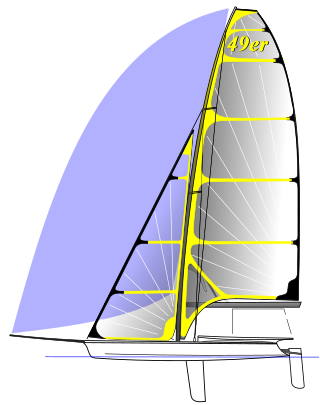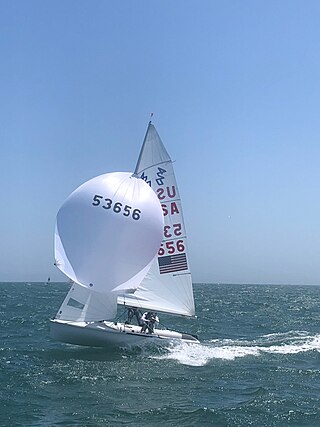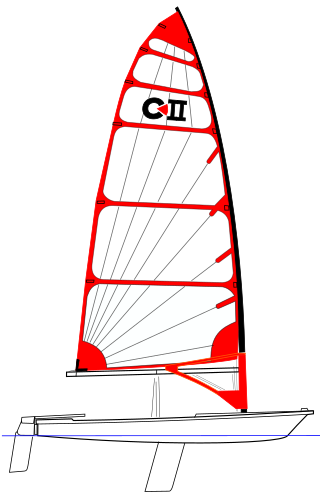Pirate  Class symbol |
 + |
| Crew | 2 |
|---|
|
| Crew | 2 |
|---|
|
| Hull weight | 218 kg |
|---|
| LOA | 5 m |
|---|
|
| Mast length | 6.29 m |
|---|
|
| Spinnaker area | 10 m2 |
|---|
| Upwind sail area | 10 m2 |
|---|
|
A Pirate is a type of German sailing dinghy. It was first constructed in 1935, and has no trapeze. The Pirate was designed in 1934 by the German boat builder Carl Martens. The boat was originally manufactured in solid wood, although since the 1960s glass-reinforced plastic, or a sandwich of the two, is also used. According to the regulations for this class of boat, kevlar and carbon fiber are forbidden.
The Pirate is a youth dinghy. It was formerly the only class used in German youth sailing championships. At present, the Pirate class is only registered in Germany. With more than 380 participants in the official rank list, it is one of the most active race classes in Germany. The Pirate is sailed by two persons, and measures 5.0 metres long by 1.6m across.
The Pirate Class has also been used by the Royal Canadian Sea Cadets as a youth trainer.
The maximum sail surface, comprising two sails, amounts to 10 m² according to the class regulations. Since the 1960s, spinnakers up to 10 m² are also permitted. The use of a Genoa or Gennaker is not permitted. The sails can be manufactured from cotton, linen or synthetic fabrics. Carbon fiber in the sails is forbidden, and may be used only as reinforcement in the windows of the sail.
The Piraatjol, a dinghy of the same name albeit in Dutch, was designed in the 1950s by Dutch naval architect Jaap Kraaier.

Dinghy sailing is the activity of sailing small boats by using five essential controls:

The Laser is a class of single-handed, one-design sailing dinghies using a common hull design with three interchangeable rigs of different sail areas, appropriate to a given combination of wind strength and crew weight. Bruce Kirby designed the Laser in 1970 with an emphasis on simplicity and performance.

The Finn dinghy is a single-handed, cat-rigged sailboat, and a former Olympic class for men's sailing. Since its debut at the 1952 Summer Olympics in Helsinki, the Finn has featured in every summer Olympics, making it the longest serving dinghy in the Olympic Regatta and one of the most prolific Olympic sailboats, currently filling the slot for the Heavyweight Dinghy. The Finn is a physically demanding boat to race at the highest levels, especially since the class rules now allow unlimited boat rocking and sail pumping when the wind is above 10 knots. The event will not feature on the Olympic programme from 2024.

The Optimist is a small, single-handed sailing dinghy intended for use by young people up to the age of 15.
The El Toro is an American pram sailboat that was designed by Charles McGregor as a sail training dinghy and yacht tender, first built in 1939. It is now often sailed as a singlehanded one-design racer.

An iceboat is a recreational or competition sailing craft supported on metal runners for traveling over ice. One of the runners is steerable. Originally, such craft were boats with a support structure, riding on the runners and steered with a rear blade, as with a conventional rudder. As iceboats evolved, the structure became a frame with a seat or cockpit for the iceboat sailor, resting on runners. Steering was shifted to the front.

The 49er and 49er FX is a two-handed skiff-type high-performance sailing dinghy. The two crew work on different roles with the helm making many tactical decisions, as well as steering, and the crew doing most of the sail control. Both of the crew are equipped with their own trapeze and sailing is done while cantilevered over the water to the fullest extent to balance against the sails.

The Laser 4.7 or ILCA 4 is a one-design dinghy class in the Laser series and is a one-design class of sailboat. All Lasers are built to the same specifications. The Laser is 4.06 m long, with a waterline length of 3.81 m. The hull weight is 59 kg (130 lb). The boat is manufactured by ILCA and World Sailing approved builders.

The International 420 Dinghy is a sailing dinghy popular for racing and teaching. The hull is fiberglass with internal buoyancy tanks. The 420 has a bermuda rig and an optional spinnaker and trapeze. It has a large sail-area-to-weight ratio, and is designed to plane easily. It can be rigged to be sailed single-handed or double-handed. The 420 is an International class recognized by World Sailing. The name refers to the boat's length of 420 centimetres.

The International 505 is a One-Design high-performance two-person monohull planing sailing dinghy, with spinnaker, utilising a trapeze for the crew.

The OK Dinghy is an international class sailing dinghy, designed by Knud Olsen in 1956.

The Byte is a small one-design sailing dinghy sailed by one person. It was designed by Canadian Ian Bruce, who also commissioned and marketed the Laser.

The Cadet is a class of sailing dinghy designed to be sailed by two children up to the age of 17. It is a one-design class, originally designed by Jack Holt in 1947. Cadets are sailed worldwide in more than 40 countries.

The International 14 is a British racing sailboat, crewed by two sailors. The class was established in 1928.

The Moth is a small development class of sailing dinghy. Originally a small, fast home-built sailing boat designed to plane, since 2000 it has become an expensive and largely commercially-produced boat designed to hydroplane on foils though many are still built at home, typically at much lower cost.

A sailing hydrofoil, hydrofoil sailboat, or hydrosail is a sailboat with wing-like foils mounted under the hull. As the craft increases its speed the hydrofoils lift the hull up and out of the water, greatly reducing wetted area, resulting in decreased drag and increased speed. A sailing hydrofoil can achieve speeds exceeding double and in some cases triple the wind speed.

The Hornet dinghy is a 16-foot-high performance dinghy designed by Jack Holt in 1952.

The NS14 is an Australian restricted development class of sailing dinghy. Measuring 14 feet in length, the class was designed the 1960 and introduced at the Northbridge sailing club in Sydney, Australia, with control of the class transferred to the NS14 Association of New South Wales in 1965. Subsequently the boat was introduced to the other states, prior to being taken to New Zealand in 1995 and the United States in 1998.
The Naples Sabot is an 8-foot (2.4 m) sailing dinghy. The Naples Sabot was designed by Roy McCullough and R.A. Violette and the first two were built in Violette's garage during WW II, although official designs were not made available until 1946. The Naples Sabot is based on the Balboa Dinghy and on Charles MacGregor's Sabot as published in Rudder magazine, April 1939. It takes its name from Naples in Long Beach, California, where it was developed.
The Tech Dinghy is an American sailing dinghy that was designed by George Owen, a professor at Massachusetts Institute of Technology (MIT), as a one-design racer and for sail training. It was first built in 1935.

















